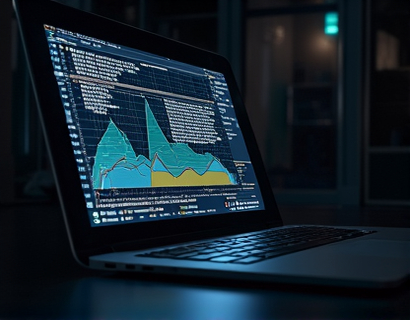Advanced Smart-Contract Solutions for UCASH and U Asset Token Management
In the rapidly evolving landscape of digital assets, the need for secure, efficient, and user-friendly token management solutions has become paramount. This article delves into the cutting-edge smart-contract technologies that are revolutionizing the way tokens pegged to UCASH and other leading digital assets are created and managed. By leveraging advanced smart-contract solutions, users can experience a significant enhancement in the security and performance of their financial ecosystems.
Understanding Token Pegging
Token pegging refers to the process of locking a token's value to that of a specific asset, such as a cryptocurrency or a commodity. This mechanism ensures that the token maintains a stable value relative to the underlying asset, providing users with a reliable store of value and a means of facilitating transactions. In the context of UCASH and other U assets, token pegging allows for the creation of tokens that mirror the value of these digital assets, offering users a seamless and secure way to participate in the market.
Smart Contracts: The Backbone of Token Management
Smart contracts are self-executing contracts with the terms of the agreement directly written into code. They run on blockchain networks, ensuring transparency, immutability, and automation. In the realm of digital asset management, smart contracts play a crucial role in creating and managing tokens. These contracts automatically enforce the rules set for token issuance, distribution, and redemption, eliminating the need for intermediaries and reducing the risk of fraud or human error.
Key Features of Advanced Smart-Contract Solutions
Advanced smart-contract solutions for UCASH and U asset token management come equipped with several key features that enhance security, efficiency, and user experience:
- Automated Token Issuance: Smart contracts can automatically issue tokens when certain conditions are met, such as the deposit of the corresponding amount of UCASH or another U asset.
- Real-Time Value Locking: Tokens are pegged in real-time to the value of the underlying asset, ensuring that the token's value remains stable and reflective of market conditions.
- Transparent Transactions: All transactions involving the tokens are recorded on the blockchain, providing a transparent and auditable trail for all participants.
- Access Control: Smart contracts can be programmed to enforce specific access controls, ensuring that only authorized users can perform certain actions, such as token redemption or transfer.
- Automated Redemption: Users can set conditions for the automatic redemption of tokens back into the underlying asset, streamlining the process and reducing manual intervention.
Enhancing Security with Smart Contracts
Security is a top priority in digital asset management, and advanced smart-contract solutions offer robust mechanisms to protect user funds and ensure the integrity of the token ecosystem. Some of the security features include:
- Immutable Ledger: The blockchain's immutable nature ensures that once a transaction is recorded, it cannot be altered or deleted, providing a high level of security against tampering.
- Decentralization: Smart contracts operate on a decentralized network, reducing the risk of a single point of failure and making it difficult for malicious actors to manipulate the system.
- Code Audits: Before deployment, smart contracts undergo rigorous code audits to identify and fix potential vulnerabilities, ensuring that the contracts are secure and reliable.
- Multi-Signature Wallets: The use of multi-signature wallets for managing token funds adds an extra layer of security, requiring multiple approvals for critical transactions.
Optimizing Performance with Efficient Smart Contracts
Performance is another critical aspect of digital asset management, and advanced smart-contract solutions are designed to optimize the efficiency of token operations. Key performance enhancements include:
- Low Latency: Smart contracts execute transactions almost instantaneously, reducing the latency associated with traditional financial systems and enabling faster decision-making.
- Scalability: Advanced smart-contract platforms are built to handle a large number of transactions simultaneously, ensuring that the system can scale with growing demand without compromising performance.
- Cost Efficiency: By automating processes and eliminating intermediaries, smart contracts reduce transaction costs, making token management more affordable and accessible.
- Real-Time Syncing: Tokens are continuously synced with the value of the underlying asset, ensuring that users always have access to the most up-to-date information and can react quickly to market changes.
Use Cases and Applications
The applications of advanced smart-contract solutions for UCASH and U asset token management are diverse and far-reaching. Some notable use cases include:
- Decentralized Finance (DeFi): Tokens pegged to UCASH can be used in DeFi protocols to provide stable lending, borrowing, and trading options, enhancing the stability and reliability of these financial services.
- Supply Chain Finance: Tokens can be used to track and manage assets throughout the supply chain, ensuring transparency and efficiency in transactions.
- Gaming and In-Game Economies: Tokens pegged to digital assets can be integrated into gaming platforms, allowing players to earn, trade, and use assets within the game and outside of it.
- NFT Marketplaces: Smart contracts can facilitate the creation, sale, and ownership transfer of non-fungible tokens (NFTs) tied to specific digital assets, providing a secure and transparent marketplace.
Future Prospects and Innovations
The future of digital asset management with advanced smart-contract solutions is promising, with several innovations on the horizon:
- Interoperability: Efforts to create interoperable smart contracts across different blockchain platforms will enable seamless token management and cross-chain transactions, expanding the reach and utility of digital assets.
- Self-Sovereign Identity: Integration of self-sovereign identity solutions with smart contracts can enhance user control over personal data and assets, providing a more secure and private experience.
- AI and Machine Learning: Incorporating AI and machine learning into smart contracts can enable predictive analytics and automated decision-making, further optimizing token management and financial strategies.
- Regulatory Compliance: As the regulatory landscape for digital assets evolves, smart contracts can be designed to comply with various regulations, ensuring that token management remains legal and compliant.
Conclusion
Advanced smart-contract solutions are transforming the way UCASH and other U assets are tokenized and managed, offering unparalleled security, efficiency, and user experience. By embracing these technologies, individuals and organizations can unlock the full potential of digital assets, participate in innovative financial ecosystems, and stay ahead in the rapidly changing world of cryptocurrency and blockchain.










































